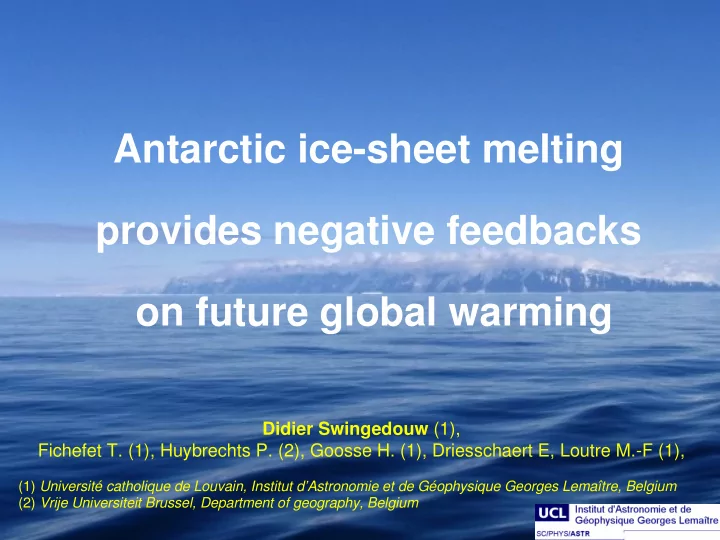

Antarctic ice-sheet melting provides negative feedbacks on future global warming Didier Swingedouw (1), Fichefet T. (1), Huybrechts P. (2), Goosse H. (1), Driesschaert E, Loutre M.-F (1), (1) Université catholique de Louvain, Institut d’Astronomie et de Géophysique Georges Lemaître, Belgium (2) Vrije Universiteit Brussel, Department of geography, Belgium
Antarctic ice sheet, THC and climate Antarctic ice sheet (AIS) : 61 m of potential sea-level rise Can the AIS melt in the future? Thermohaline circulation (THC): What could be the climatic impact of this melting? Oceanic circulation related to temperature and salinity gradient Can this melting stabilize the North Atlantic THC? Freshwater input in the Southern NADW Ocean can explain warm periods in Are the AIS-climate interactions important the North Atlantic (Bølling-Allerød, for sea-level rise projections? Weaver et al. 2003) Future of the THC: no Antarctic ice- AABW sheet melting in most IPCC models Rahmstorf . 2002
Tool: L0VECLIM earth system model ECBILT QG, T21, 3 levels ISM CLIO VECODE 10km GCM, 3°x3°, 20 levels 31 levels
Experimental design CO2 (ppm ) We analyse several scenario 1120 simulations at 4XCO2 4xCO2 CTRL Without any ice-sheet 280 melting (fixed) Sans 0 140 3000 Year With ice-sheet melting from both Greenland and Antarctic ice sheets ( AGIS ) With melting from Greenland AGIS AIS GIS ice sheet only ( GIS ) With melting from Antarctic ice sheet only ( AIS )
CTRL AGIS fixed AIS GIS Grounded AIS mass balance AIS response Ablation Accumulation AIS looses mass after a few centuries Important warming over SAT in summer: fixed-CTRL (2900-3000) Antarctica after 3000 years Lag due to large thermal inertia in the Southern Ocean Freshwater input up to 0.14 Sv in the Southern Ocean after 3000 years in AGIS and AIS
Temperature response in scenarios AGIS-fixed : years 2900-3000 Surface Air Temperature (SAT) AIS melting a) SAT reduces the Climate Sensitivity by 10% b) Sea-ice thickness SAT: AGIS-fixed The north is warming, the south is cooling Because of sea- ice differences
AABW cell response in scenarios The AABW cell weakens the first 300 years AABW export at 30°S Then it recovers AIS It stabilizes around AGIS CTRL value with AIS melting CTRL GIS And 25% over CTRL fixed value without AIS melting
NADW cell response in scenarios NADW export at 30°S AABW AIS CTRL NADW fixed AGIS GIS NADW NADW cell weakens more with GIS AABW melting (Driesschaert et al. 2007), while AIS melting reduces this weakening An illustration of the « bipolar ocean seesaw » process from Stocker et al. (1992) Poster XY0162 on Friday
Climate-ice sheet feedback Ice-sheet melting • Elevation and • Temperature Albedo (+) Sign? • Precipitation • Freshwater Amplitude? input into the oceans (-) •… Climate
Climate-ice sheet feedback Sea-level rise Ice-sheet = melting Grounded ice-sheet melting + Thermal expansion in the oceans Climate
AIS elevation AGIS AIS-climate feedback (coupled) after 3000 years AIS coupled with climate: AIS melts as much as 3.2 m sea-level rise equivalent fixed AIS uncoupled with climate: AIS melts as (uncoupled) much as 10.0 m sea-level rise equivalent Strong negative feedback: freshwater input feedback dominates over the others Ocean Temperature: AGIS-fixed Thermal expansion contribution: 2.3 m when coupled; 1.2 m when fixed Total negative feedback of 5.7 m
Conclusions AIS melting reduces global warming especially in the Southern Hemisphere AIS melting reduces the Atlantic THC weakening AIS melting is governed by a strong negative feedback implying climate interactions For all these reasons, AIS has to be coupled interactively in climate models for long-term projections
Poster XY0162 on Friday, Swingedouw et al. Thank you ! Thank you ! Mailto: swingedo@cerfacs.fr Mailto: swingedo@cerfacs.fr Web: http://dods.ipsl.jussieu.fr/dssce/public_html/index.html Web: http://dods.ipsl.jussieu.fr/dssce/public_html/index.html
Recommend
More recommend